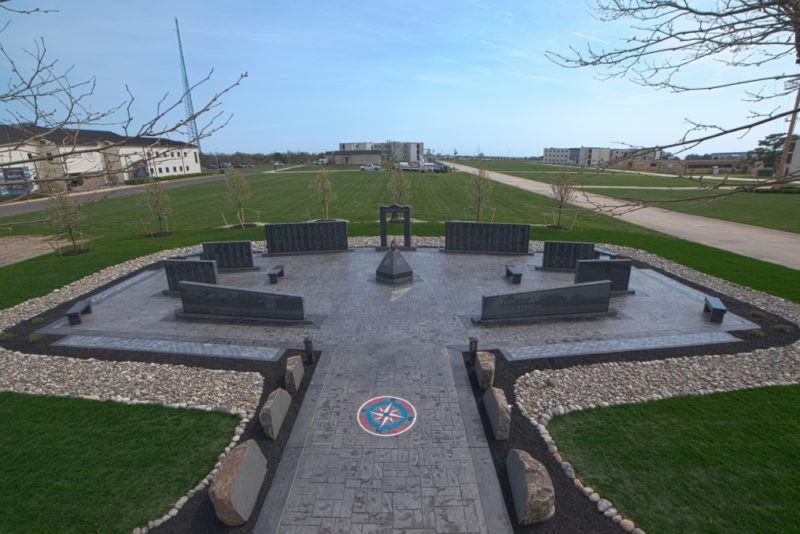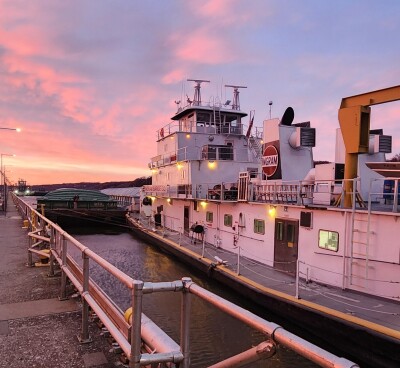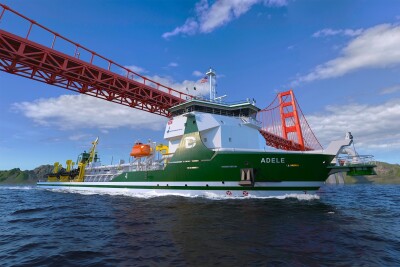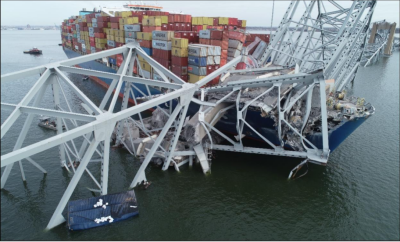The names of more than 1,700 Coast Guard enlisted who died in the line of duty are inscribed on a granite monument dedicated Saturday at the Coast Guard Training Center Cape May in New Jersey.
The names date to 1915, the year the Revenue Cutter Service and Life Saving Service were merged to make the Coast Guard. Their names, ratings and dates of death include men and women lost in war, and those who gave their lives saving others.

Granite slabs are inscribed with the names of Coast Guard enlisted who died in service since 1915. Kirk Moore photo
“That is our brand, that is our ethos in action,” said Capt. Owen Gibbons, commander of the training center.
The first memorial to all those lost was eight years in the making with the Coast Guard Enlisted Memorial Foundation, a small volunteer group that with help from Coast Guard enlisted leadership raised $450,000 from donors, veterans groups and other fundraisers.
“This was a grassroots effort, and it wasn’t a big grassroots effort,” said Master Chief Petty Officer Jason Vanderhaven. “I was a chief when this started.”
Foundation president Tom Dougherty, a retired chief petty officer, said the first idea came after the loss of petty officer Shaun Lin, who died during a 2010 law enforcement exercise on the James River in Virginia when he fell while trying to transfer from a 25’ small boat to a cutter.

Master Chief Petty Officer Jason Vanderhaven speaks at the dedication of the Coast Guard Enlisted Memorial. Kirk Moore photo
Talking about Lin’s death brought a realization there was no memorial to those lost – indeed, no central tally of casualties. That prompted Capt. William Kelly, then-commander of the Cape May Training Center, and Master Chief Petty Officer Dawn Smith in 2012 to begin talking about the possibilities for a memorial.
American Bronze & Stone, Englewood, N.J., was contracted by the foundation to design and build the monument. As word spread of the effort other retired Coast Guard and veterans’ and civic groups came forward.
“Right after they got started I reached out to Tom Dougherty and said we’d like to help,” said Hank Korker of the American Legion Post 493 of Mystic Island in Little Egg Harbor, N.J. A 21-year Coast Guard veteran, Korker said the post also got involved with collecting donations for Coast Guard families affected by the federal budget shutdown in early 2019.
“It’s great to come down and see the result of everyone’s hard work,” he said. The fundraising “allowed us to do things we hadn’t thought of,” including artistic ocean scenes on granite walls, irrigation for plantings and a low-level lighting system so the memorial can be viewed in evening, said Dougherty.
The location of the memorial was chosen to both honor the enlisted ranks, and inspire new recruits. It is right on the edge of the training center parade ground, and the current Golf and Hotel training companies were in attendance for the dedication.
“The openness of the memorial also allows company commanders to bring their recruits here” and instill the ethos of the service, Dougherty said.

Commandant Adm. Karl Schultz talks with D-Day veteran Frank DeVita, left, and son Richard DeVita at the dedication of the Coast Guard Enlisted Memorial. Kirk Moore photo
Smith and other foundation volunteers worked through Coast Guard archives to document and check casualty record for accuracy so they could be inscribed on the walls. The names include victims of German U-boat attacks in World War II, and those of the simmering drug war on today’s maritime borders. One of the recent names is Terrell Horne III, who was killed after he pushed fellow crew members to safety before drug smugglers rammed their boat near Santa Cruz Island off the Southern California coast in December 2012.
There is much blank space on the granite slabs. Another name to be added soon is Michael Kozloski, a chief warrant officer who was fatally injured Jan. 31 in a crane accident at the Coast Guard buoy yard at Homer, Alaska, said Coast Guard Commandant Karl Schultz.
Among the audience of several hundred were families of those lost, including the family of Seaman Recruit Aaron Redd. Redd, 21, of Manahawkin, N.J., died in July 2016, a week after enlisting, after collapsing during a 1.5 mile initial fitness assessment run with his company Delta 193. A Coast Guard report concluded Redd’s death was caused by heat-related illness, exacerbated by an underlying medical condition.

Retired Cmdr. Terry O'Connell, right, and Steve Petersen of the Coast Guard Combat Veterans Association were among those attending the dedication of the Coast Guard Enlisted Memorial. Kirk Moore photo
Coast Guard veterans were thick in the crowd too. Schultz gave a shout out to the oldest – Frank DeVita, 94, who was a gunner on a Higgins landing craft during the D-Day invasion on the Normandy coast of France June 6, 1944.
“This is a really big deal for those of us who were here,” said retired Cmdr. Terry O’Connell of St. Louis, Mo., who graduated boot camp at Cape May in 1960 and went on the be chief of aids to navigation with the old Second Coast Guard District.





